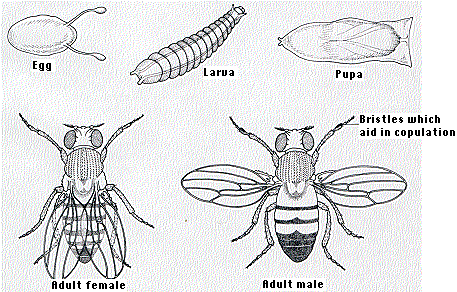Drosophila melanogaster
Within a few years of the rediscovery of Mendel's rules in 1900, Drosophila melanogaster (the so-called fruit fly) became a favorite "model" organism for genetics research.
Some of the reasons for its popularity:

- The flies are small and easily reared in the laboratory.
- They have a short life cycle The figure shows the various stages of the life cycle (not all drawn to the same scale). A new generation of adult flies can be produced every two weeks.
- They are fecund; a female may lay hundreds of fertilized eggs during her brief life span. The resulting large populations make statistical analysis easy and reliable.
- The giant ("polytene") chromosomes in the salivary (and other) glands of the mature larvae.
- These chromosomes show far more structural detail than do normal chromosomes, and
- they are present during interphase when chromosomes are normally invisible.
More recently, Drosophila has proven in other ways to have been a happy choice.
- Its embryo grows outside the body and can easily be studied at every stage of development.
- The blastoderm stage of the embryo is a syncytium (thousands of nuclei unconfined by cells) so that, for example, macromolecules like DNA injected into the embryo have easy access to all the nuclei.
- The genome is relatively small for an animal (less than a tenth that of humans and mice). [View]
- Mutations can targeted to specific genes. [Link to discussion of transposons.]
Follow these links to examples of things that Drosophila has taught us.
13 November 2002
